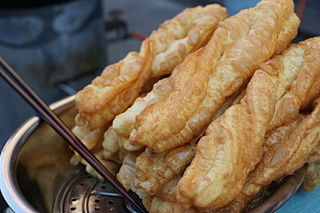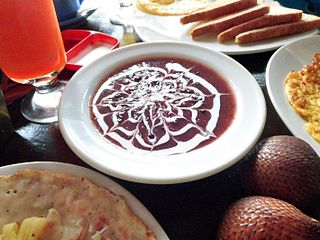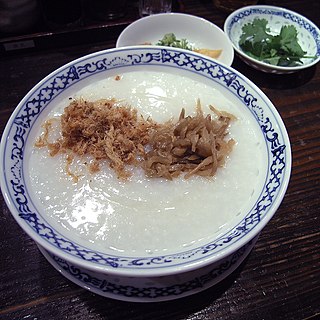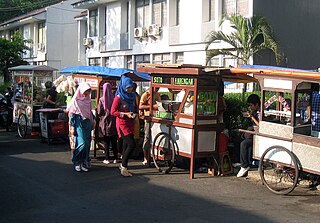
Porridge is a food commonly eaten as a breakfast cereal dish, made by boiling ground, crushed or chopped starchy plants—typically grain—in water or milk. It is often cooked or served with added flavorings such as sugar, honey, (dried) fruit or syrup to make a sweet cereal, or it can be mixed with spices or vegetables to make a savoury dish. It is usually served hot in a bowl, depending on its consistency. Oat porridge, or oatmeal, is one of the most common types of porridge. Gruel is a thinner version of porridge.

Malay cuisine is the cooking tradition of ethnic Malays of Southeast Asia, residing in modern-day Malaysia, Indonesia, Singapore, Brunei, southern Thailand and the Philippines as well as in Cocos Islands, Sri Lanka and South Africa. Different Malay regions are all known for their unique or signature dishes—Pattani, Terengganu and Kelantan for their nasi dagang, nasi kerabu and keropok lekor; Pahang and Perak for its durian-based cuisine, gulai tempoyak; Kedah and Penang for their northern-style asam laksa and rojak; Satun and Perlis for its bunga kuda dessert; Negeri Sembilan for its lemak-based dishes; Malacca for their spicy cincalok; Singapore for their rojak bandung and roti prata; Riau for its ikan patin dishes, gulai ikan patin and asam pedas ikan patin; Riau Islands for their sup ikan; West Sumatra for its rendang and lemang; Deli Malays of North Sumatra for their nasi goreng teri medan and gulai ketam; Jambi for its ikan mas panggang and tempoyak; Palembangese Malays of South Sumatra for their pempek, mi celor and nasi minyak; Bangka Belitung for its siput gonggong and terang bulan; Betawi Malays of Jakarta for their nasi kebuli, nasi ulam and kue ku snack; West Kalimantan and Sarawak for its bubur pedas and ayam pansuh; Brunei for their nasi katok and unique ambuyat dish; Sri Lankan Malays of Sri Lanka for its kalu dodol; and Cape Malays of South Africa for their bobotie, boeber and koe'sister.

Youtiao, is a long golden-brown deep-fried strip of dough commonly eaten in China and in other East and Southeast Asian cuisines. Conventionally, youtiao are lightly salted and made so they can be torn lengthwise in two. Youtiao are normally eaten at breakfast as an accompaniment for rice congee, soy milk or regular milk blended with sugar. Youtiao may be known elsewhere as Chinese cruller, Chinese fried churro, Chinese oil stick, Chinese doughnut, Chinese breadstick, and fried breadstick,

A warung is a type of small family-owned business — a small restaurant or café — in Indonesia, and to a lesser extent, Malaysia. A warung is an essential part of daily life in Indonesia. Today, the term warung has slightly shifted — especially among foreign visitors, expatriates, and people abroad — to refer more specifically to a modest Indonesian restaurant or a place that sells things Indonesian. But for the majority of Indonesians, the meaning is still a small, neighborhood convenience shop, often a front room in a family's home.

Lontong is an Indonesian dish made of compressed rice cake in the form of a cylinder wrapped inside a banana leaf, commonly found in Indonesia, Malaysia and Singapore. Rice is rolled inside a banana leaf and boiled, then cut into small cakes as a staple food replacement of steamed rice. The texture is similar to those of ketupat, with the difference being that the ketupat container is made from weaved janur fronds, while lontong uses banana leaf instead.

Javanese cuisine is the cuisine of Javanese people, a major ethnic group in Indonesia, more precisely the province of Central Java, Yogyakarta and East Java. Though the cuisine of Sumatra is known for its spiciness with notable Indian and Arabic influences, Javanese cuisine is more indigenously developed and noted for its simplicity. Some of Javanese dishes demonstrate foreign influences, most notably Chinese.

Padang food or Minang food is the cuisine of the Minangkabau people of West Sumatra, Indonesia. It is among the most popular food in Maritime Southeast Asia. It is known across Indonesia as Masakan Padang after the city of Padang the capital city of West Sumatra province. It is served in restaurants mostly owned by perantauan (migrating) Minangkabau people in Indonesian cities. Padang food is ubiquitous in Indonesian cities and is popular in neighboring Malaysia and Singapore.

Tinutuan, also known as bubur manado or Manadonese porridge is a specialty of the Manado cuisine and a popular breakfast food in the city of Manado and the surrounding province of North Sulawesi, Indonesia. Tinutuan is a congee made from rice, pumpkin and sweet potato or cassava cooked up into a pulp, which is then mixed with corn kernels and various leafy vegetables such as kangkung, kemangi, melinjo, and bayam (amaranth). Finally it is served with many toppings that may include fried shallots, fried tofu, spring onions, leeks, coriander, chili, condiments like sambal and dabu-dabu, and smoked or salted fish, usually skipjack tuna, anchovies, or nike.

Papeda, or bubur sagu, is sago congee, a staple food of native people in Maluku Islands and Western New Guinea. It is commonly found in eastern Indonesia, as the counterpart of central and western Indonesian cuisines that favour rice as their staple food.

Bubur ayam is a Chinese Indonesian chicken congee. It is rice congee with shredded chicken meat served with some condiments, such as chopped scallion, crispy fried shallot, celery, tongcay, fried soybean, Chinese crullers, and both salty and sweet soy sauce, and sometimes topped with yellow chicken broth and kerupuk. Unlike many other Indonesian dishes, it is not spicy; sambal or chili paste is served separately. It is a favourite breakfast food, served by humble travelling vendors, warung, fast food establishments, and five-star hotel restaurants. Travelling bubur ayam vendors frequently pass through residential streets in the morning selling the dish.

Balinese cuisine is a cuisine tradition of Balinese people from the volcanic island of Bali. Using a variety of spices, blended with the fresh vegetables, meat and fish. Part of Indonesian cuisine, it demonstrates indigenous traditions, as well as influences from other Indonesian regional cuisine, Chinese and Indian. The island's inhabitants are predominantly Hindu and culinary traditions are somewhat distinct with the rest of Indonesia, with festivals and religious celebrations including many special foods prepared as the offerings for the deities, as well as other dishes consumed communally during the celebrations.

Bubur pedas is a traditional porridge dish for the Malays both in Sambas, West Kalimantan (Indonesia) and Sarawak (Malaysia). It is usually served during Ramadan after the Muslim ending their fast on the iftar time.

Bubur ketan hitam, bubur pulut hitam or bubur injun is an Indonesian sweet dessert made from black glutinous rice porridge with coconut milk and palm sugar or cane sugar. The black glutinous rice are boiled until soft, and sugar and coconut milk are added. It is often described as "black glutinous rice pudding" and is very similar to black rice tong sui made from black rice. It is often served as dessert or snack, for supper, for tea time, anytime of the day; however, it is a popular choice for breakfast for those who prefer sweet treat instead of its savory counterpart bubur ayam.

Betawi cuisine is rich, diverse and eclectic, in part because the Betawi people that create them were composed from numbers of regional immigrants that came from various places in the archipelago, as well as Chinese, Indian, Arab, and European traders, visitors and immigrants that were attracted to the port city of Batavia since centuries ago.

Bubur kacang hijau, abbreviated Burjo is an Southeast Asia sweet dessert made from mung beans porridge with coconut milk and palm sugar or cane sugar. The beans are boiled till soft, and sugar and coconut milk are added.

Congee or conjee is a type of rice porridge or gruel. When eaten as plain rice congee, it is most often served with side dishes. When additional ingredients such as meat, fish, and flavourings are added while preparing the congee, it is most often served as a meal on its own, especially for persons who are ill. Names for congee are as varied as the style of its preparation. Despite its many variations, it is usually a thick porridge of rice largely disintegrated after prolonged cooking in water.

Indonesian street food is a collection of ready-to-eat meals, snacks, fruits and drinks sold by hawkers or vendors at warung food stalls or food carts. Street food in Indonesia is a diverse mix of local Indonesian, Chinese, and Dutch influences. Indonesian street food are usually cheap, offer a great variety of food of different tastes, and can be found on every corner of the city.
Sarawakian cuisine is a regional cuisine of Malaysia. Like the rest of Malaysian cuisine, Sarawak food is based on staples such as rice but there is a great variety of other ingredients and food preparations due to the influence of the state's varied geography and indigenous cultures quite distinct from the regional cuisines of the Peninsular Malaysia. Sarawak is famous for its multi-ethnic population. As the homeland of many unique communities, Sarawak has a variety of cuisines rarely found elsewhere in Malaysia. The uniqueness of Sarawak well depends on its ethnic groups. Every native group in Sarawak has their own lifestyle, traditions, cultures and also foods. Sarawak cuisine is less spicy and has a subtle in taste. It uses fresh seafood and natural herbs like turmeric, lemongrass, ginger, lime and tapioca leaves. These ingredients are not only easily available, but also add a hint of aroma, texture and freshness to the delicacies. Food is one of the most cultural identities for natives group in Sarawak with each ethnic has their own delicacies. The Iban popular with “tubu” (stems), “tuak” and “pansuh”, the Malay with “bubur pedas” (porridge) and “kek lapis Sarawak”, the Bidayuh with “asam siok” and “sup ponas Bidayuh”, the Melanau with “tebaloi”, “sagu” and “umai” and Orang Ulu well known with “garam barrio”, “kikid” (broth), “tengayen”, and “urum giruq” (pudding).

Acehnese cuisine is the cuisine of the Acehnese people of Aceh in Sumatra, Indonesia. This cuisine is popular and widely known in Indonesia. Arab, Persian, and Indian traders influenced food in Aceh although flavours have changed a lot their original forms. Combination of spices in Acehnese cuisine just as are commonly found in Indian and Arab cuisine, such as ginger, pepper, coriander, cumin, cloves, cinnamon, cardamom and fennel. A variety of Acehnese food is cooked with curry and/or coconut milk, which is generally combined with meat such as buffalo, beef, mutton, fish, or chicken.


















